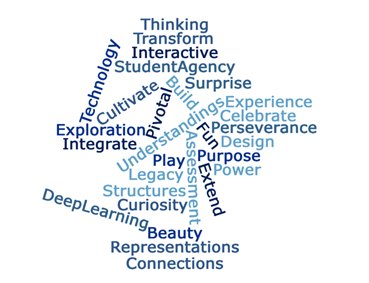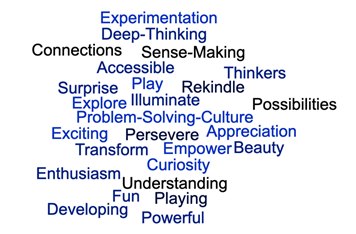Bringing Joy to Teaching and
Learning Mathematics
March 2022
What does it mean to bring joy to the teaching and learning of mathematics? Why is it important? When we bring joy, we provide powerful opportunities for students to understand mathematical ideas, build their positive mathematical identity, foster their love of learning mathematics, make connections, and see
mathematics in the world around them.
In February and March, we held our first NCTM Regional Conferences in person since the beginning of COVID-19. They were both inspiring events, filled with opportunities to hear from speakers, share ideas, and engage in conversations within the mathematics education community. Attendees were excited to be together
again. Each conference included strands that focused on joy. Here are word clouds from those sessions related to joy. It is interesting to see so many powerful things connected to joy in teaching and learning mathematics. Take a moment to pause and reflect. What do you notice? What do you wonder?
|
NCTM 2022 New Orleans Regional Conference |
NCTM 2022 Indianapolis Regional Conference |
 |
 |
As we consider broadening the purposes of school mathematics as described in
NCTM’s Catalyzing Change series, we should prioritize the development of deep conceptual understanding so that students—all learners—experience the wonder, joy, and beauty of mathematics as well as confidence in themselves as mathematicians. From early
childhood, students should have opportunities to experience the joy of learning mathematics that carries on through elementary, middle, and high school years and beyond. When is mathematics joyful? “Mathematics becomes joyful when children have opportunities to learn mathematics in ways they see as relevant
to their identities and communities and when they are encouraged to explore, create, and make meaning in mathematics” (NCTM 2020, p. 17).
Although a number of aspects regarding joy connect to exploring, creating, and making meaning, consider the role of play in the mathematics learning experience. For young children, play is usually a central part of their world; but oftentimes as children get older, they engage less and less in play. But we all—children
and adults—need opportunities to play with mathematical ideas and experience the joy of mathematics. Amy Noelle Parks (2020, p. 61) wrote that in her experience with children, choosing joy leads to richer and more productive mathematics. She offered five research-based strategies to get us started
creating joy in the mathematics classroom:
- Create space for play.
- Allow children to make choices.
- Offer problems that allow for exploration, social interaction, and material engagements.
- Relax a little about time on task.
- Create caring relationships.
Which one or ones do you already embrace, and which do you want to focus on more this year? How can we implement these across PK–12 and beyond? Kate Degner (2022) recently wrote an article discussing the importance of play in middle school and illustrated with a problem from MTLT’s Problems to Ponder. Although the
title says middle school, the article applies to high school as well. Check it out! It is powerful!
In a blog in 2018,
Parks wrote about this idea of play as not only a matter of what research tells us but also ethics. She reminded us that learning theory tells us that students learn best when engaged and not stressed: “If our teaching practices are making children sad, then it doesn’t
matter what they might do in terms of mathematics achievement because it is simply not okay for the adults of a species to send their young every day to a place that makes them miserable.” I have to say that when I read this, it made me reflect on my years as a high school teacher and my work today with
preservice teachers. How many times were my students experiencing joy, and when were they not? What was I doing? What were they doing? What contributed to the classroom culture? What outside the classroom was contributing?
The beauty of it is that in visiting classrooms, albeit virtually many times, and talking with teachers all across the United States, Canada, and literally the world now, I see that teachers are committed to bringing joy to students in learning
mathematics. It is wonderful to see what you are doing each day to bring mathematical joy to your students. You bring your passion and joy to the learning experience and share this with your students. I have watched and learned with awe at your work to bring the most empowering learning experiences
to your students. Is it easy? No, not always. Do we do it perfectly every day? Probably not. But you remain committed and vigilant to bringing joy in learning to the mathematics classroom.
How do we do this? There are many ways, but here are a few:
- Be intentional in creating learning experiences that bring joy of learning mathematics.
- Encourage students to be curious and creative and to ask questions.
- Celebrate the brilliance and unique contributions of our students.
- Challenge students to explore and make connections.
- Inspire students to see mathematics as they encounter their world and make meaning of it.
- Situate students in tasks in which they can find joy in productive struggle that is appropriately supported.
These actions expand our students’ professional and personal opportunities.
I recently read through the latest issue of MTLT, March 2022, and I must say, it is packed with joy! You should read it all, but here is sample from Thomasenia Lott Adams:
“I love how knowing mathematics makes me feel. When I am confident about something mathematical, I am confident all around. When I have mastered a mathematical process, when I have made a mathematical connection, when I have successfully applied a mathematical
concept, I am bursting with joy. At times I have jumped out of my seat to cheer because of reaching a point of success in a mathematical challenge!” (p. 166)
Bursting with Joy! Let’s all (and our students, too) jump out of our seats and cheer about mathematics with Adams! That’s joy! Let’s find our joy, focus on our joy, and bring that joy to the teaching and learning of mathematics. Let’s help each other in finding the joy on this journey of teaching and learning mathematics.
Trena Wilkerson
NCTM President
@TrenaWilkerson
References
Adams, Thomasenia Lott. 2022. “I’m in Love . . . with Mathematics.” Mathematics Teacher:
Learning and Teaching PK–12 115, no. 3 (March): 166–67.
Degner, Kate. 2022. “The Importance of Play in Middle School Mathematics.” Mathematics Teacher: Learning and
Teaching PK–12 115, no. 2 (February): 131–38.
National Council of Teachers of Mathematics (NCTM). 2020. Catalyzing Change in Early
Childhood and Elementary School Mathematics: Initiating Critical Conversations. Reston, VA: NCTM.
Parks, Amy Noelle. 2020. “Creating Joy in PK–Grade 2. Mathematics Classrooms.” Mathematics Teacher: Learning and
Teaching PK–12 113, no. 1 (January): 61–64.